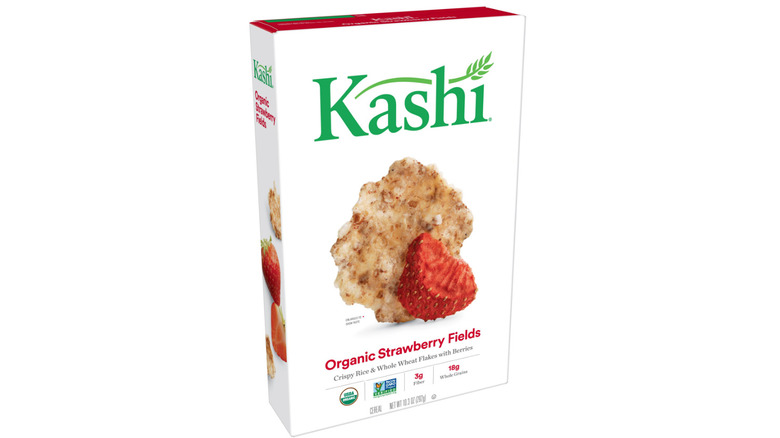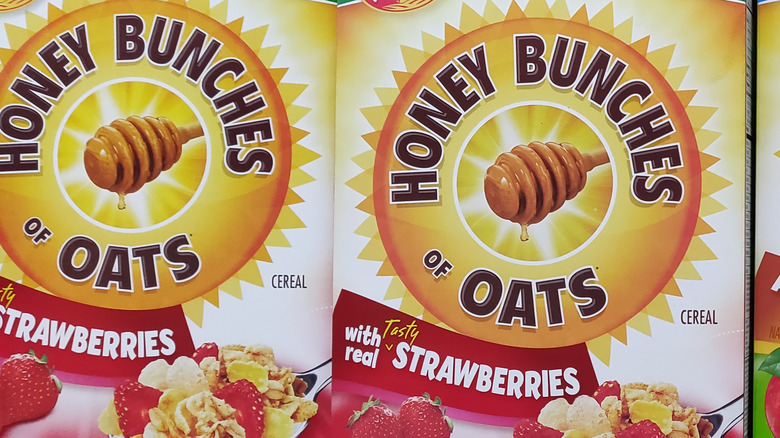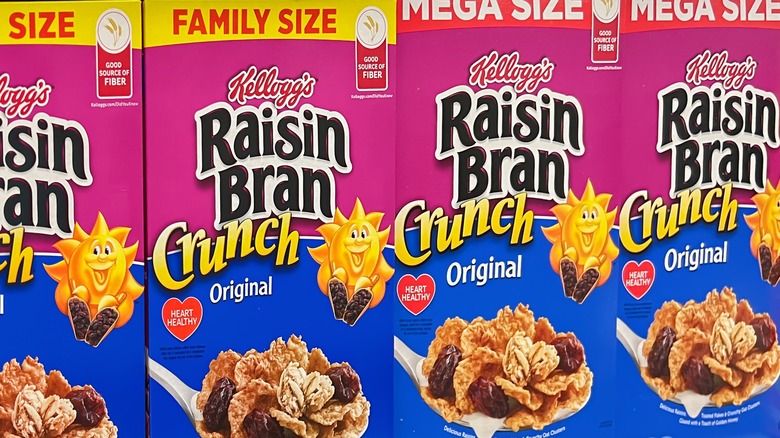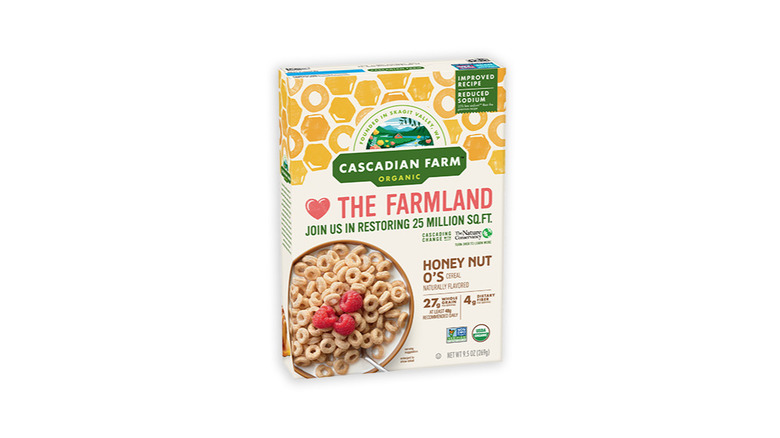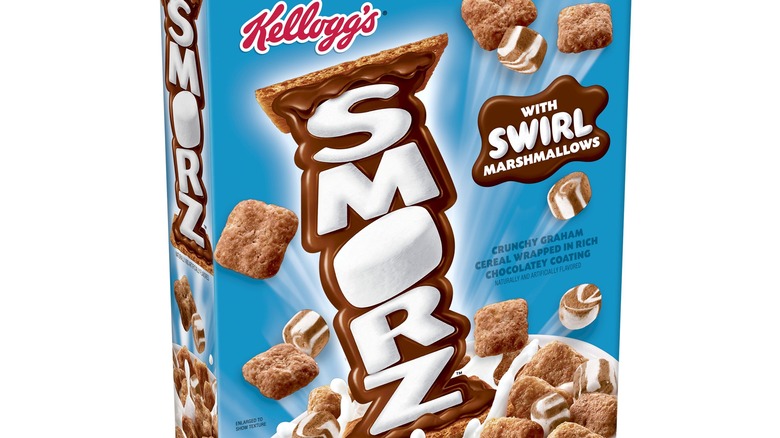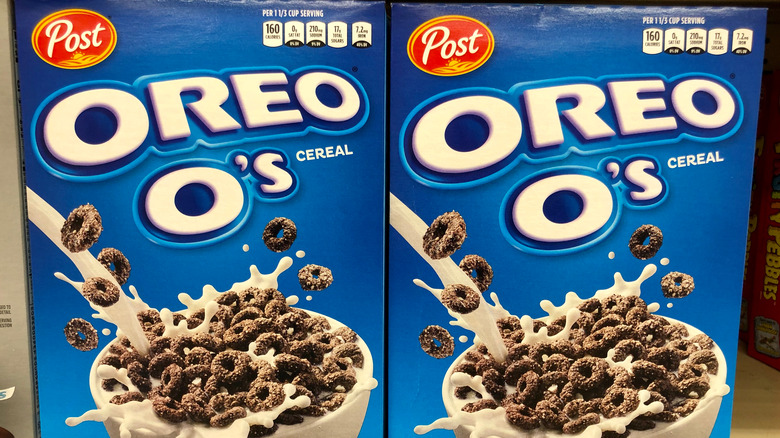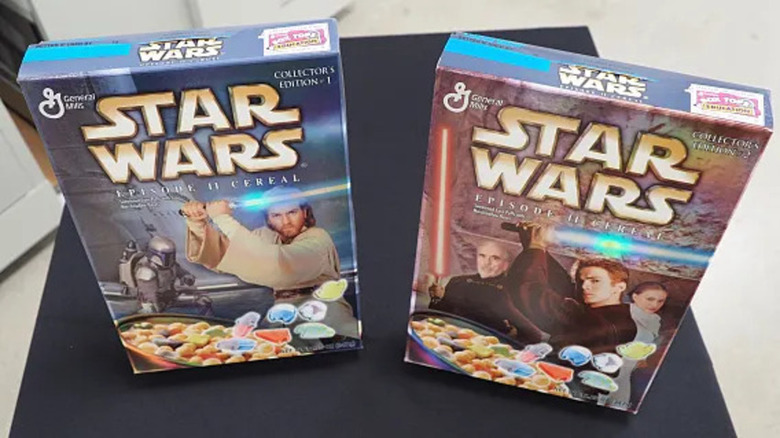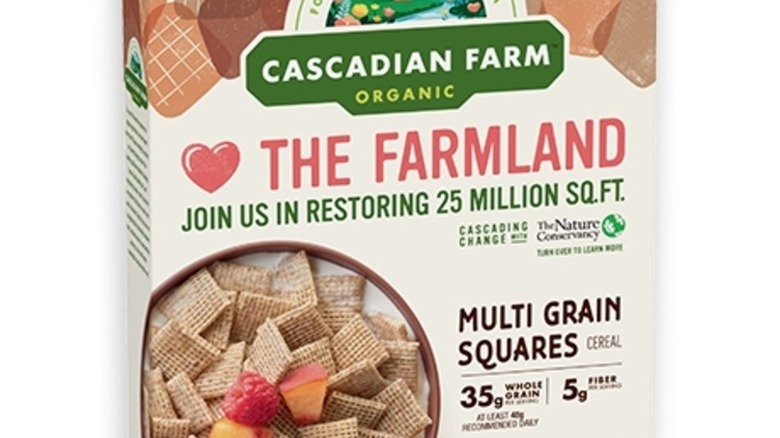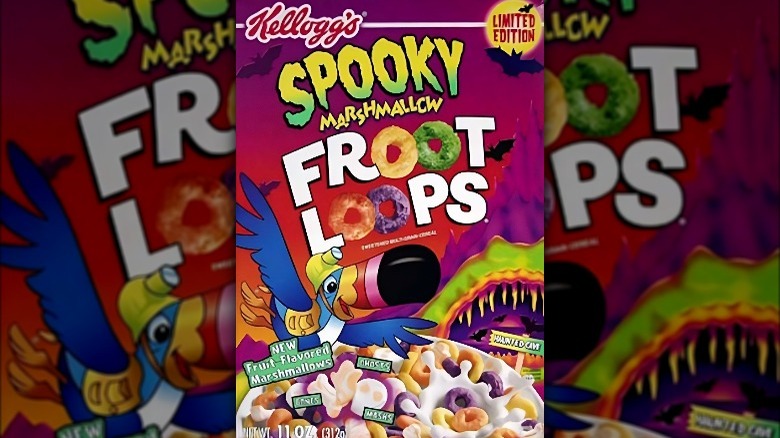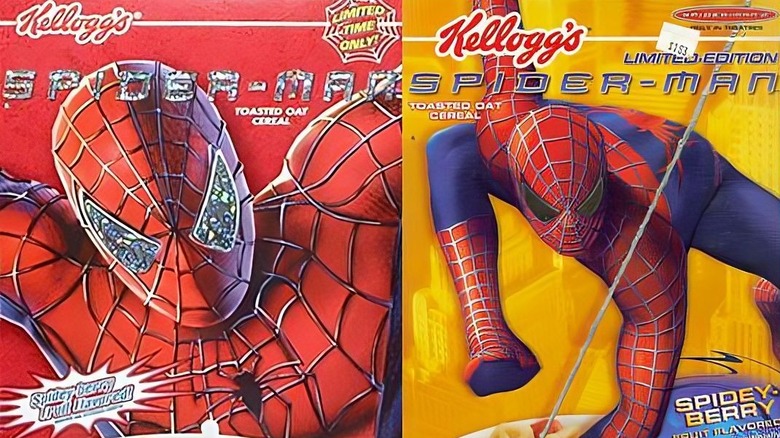10 Cereals You Won't Believe Are 20 Years Old
While some breakfast cereals have become stalwarts of dining tables and pop culture, many others are gone from supermarket aisles before you know it. According to a 2018 InterviewQs article, more than half of all cereals ever created have been launched since 1980 — and about half of these are pulled from production for good within five years. This means that, for adults who grew up in the late 1990s or early 2000s and want a bowl of nostalgia, it could be a toss-up whether their childhood favorite is still available.
Luckily, there is a spoonful of cereals from this era that survived at least in some way, shape, or form. Today, we're looking at 10 breakfast cereals you won't believe are 20 years old — or a little older in a few cases. Some of them have been on shelves non-stop since day one. Others took a break for various reasons only to come back in style. A few feel like they've been around forever while a couple will make you say, "Wait, that cereal is really 20 years old?"
Whatever the story behind them, there's still room for these cereals in people's hearts and stomachs. Considering how many options are available — IBISWorld notes there are 70 U.S. companies making cereal as of 2022, while Credit Donkey claims you can purchase more than 1,000 different varieties at any given moment — that's no small feat. Let's dive into these 20-year-old cereals (or 20-plus) and see how they're standing the test of time.
1. Kashi Organic Strawberry Fields
Even if you're not a fan of the Beatles, you can still enjoy a bowl of Kashi Organic Strawberry Fields. As noted by Mr. Breakfast, this multi-grain flake cereal with freeze-dried strawberries and raspberries debuted on October 3, 2002. Strawberry Fields was introduced in tandem with Kashi Cranberry Sunshine as part of the new Kashi Organic Promise line. Both were claimed to be among the first cereals to meet the new National Organic Standards that went into effect on October 21 of that year. These stated food items must be at least 95% organic to be labeled as "USDA Organic."
Strawberry Fields also signified a major shift for Kashi. The company was created in 1984 and already offered alternative cereals as part of its lineup (via Supermarket News). But in 2000, cereal giant Kellogg's purchased Kashi, letting them enter the natural food market. And not surprisingly, they've emphasized morphing Kashi into a notable cereal brand, with the official website now listing 20 varieties.
But while Cranberry Sunshine is no longer one of those 20, Organic Strawberry Fields is still going strong. Kashi even trademarked the term "Strawberry Fields" in 2013 for use with food items (via Justia). It's also one of the simplest cereals around with SmartLabel listing only eight ingredients, seven of which are certified organic — ironically, the only one that isn't is sea salt.
2. Honey Bunches of Oats with Real Strawberries
Apparently, strawberries were trendy in 2002, because in addition to Kashi Strawberry Fields, that year also brought us Honey Bunches of Oats with Real Strawberries. A product of Post Consumer Brands, the original Honey Bunches of Oats first hit shelves in 1989 and quickly became a huge success. Zippia lists it as the fourth-largest U.S. cereal brand of 2022 behind only Cheerios, Frosted Flakes, and Honey Nut Cheerios.
And when something is a success, variations are almost inevitable. This early expansion to the product line takes the basic Honey Bunches of Oats formula — which itself was spawned by Post employee Vernon J. Herzing mixing different cereals in his home kitchen — and mixes in dried strawberries. The result is a blend of flakes, oat clusters, fruit, and a touch of honey. As the company's website proclaims, "There's more to love in every bite."
Though not as popular as the original, Honey Bunches of Oats with Real Strawberries has been beloved enough to reach its 20th anniversary. That's even more impressive when you consider Mr. Breakfast lists 25 Honey Bunches of Oats varieties introduced over the years — and yet, as of 2022, only eight are still available, per Honey Bunches of Oats. While there have been a lot of duds, adding strawberries to this cereal medley is one variation that has endured.
3. Raisin Bran Crunch
We can still remember the original Raisin Bran Crunch tagline like it was yesterday: "Tastes so good, breakfast is back." If you don't remember, you can watch it on YouTube. So it was jolting to learn from Brand Informers that Raisin Bran Crunch was introduced back in 1999. Raisin bran itself is one of the oldest cereals around — the South Florida Reporter writes that Skinner's Manufacturing Company created raisin bran in 1925, and Mr. Breakfast adds that both Kellogg's and Post introduced their versions in 1942.
But Raisin Bran Crunch has been wildly successful in its own right, with Kiplinger ranking it 16th in its 2018 list of best-selling cereals — only five spots behind Kellogg's original recipe. As noted on the official website, the recipe adds honey-oat granola clusters to the wheat flakes and raisins for extra crunchiness and sweetness. The Crunch version also has a little more sugar with slightly less fiber and protein than the original raisin bran, though both have the same calorie count.
How successful has Raisin Bran Crunch been? There are now variations on the variation. Raisin Bran Crunch Vanilla Almond is available per Kellogg's Raisin Bran website, and In their list of Kellogg's cereals, Mr. Breakfast adds that Raisin Bran Crunch Apple Strawberry was previously attempted. Now the prototype version has its own "Original" tag, showing perhaps no late-1990s/early-2000s cereal has earned a firmer foothold in the pantry.
4. Honey Nut O's
We're sure some of you are already thinking that Honey Nut O's just sounds like a generic Honey Nut Cheerios rip-off. And when you look at the labels for both cereals, there are a lot of similarities, beginning with whole grain oats as the first ingredient. The primary differences appear to be that 1) Honey Nut O's is certified as USDA Organic, 2) it contains almond flavoring rather than actual almonds, and 3) the box is smaller (9.5 ounces vs 10.8 ounces).
But there's nothing ordinary about the story behind this cereal. It's a product of Cascadian Farm, which was founded in 1972 by Gene Kahn as a simple organic home farm. As the company grew, it began producing an assortment of supermarket foods — and in 1999, General Mills purchased the Cascadian Farm brand through its acquisition of Small Planet Foods.
In a shock to no one, General Mills decided to add cereal to the Cascadian Farm line-up, and Honey Nut O's was part of the inaugural unveiling in 2002. And you know who owns Honey Nut Cheerios? That's right: General Mills. It doesn't take a rocket scientist to infer they would create an organic version of what, according to Zippia, is the third-most-popular cereal in the U.S. We can't blame them for trying to capitalize — and since Honey Nut O's are still found in stores from coast to coast, it clearly has worked.
5. Smorz
"S'more" is short for "some more," and for 20 years and counting, people have wanted more Smorz cereal. According to Mr. Breakfast, it was first released in 2002, with the official website describing it as "crunchy graham crackers in a rich chocolatey coating with — of course — sweet marshmallows!" Supposedly, at its peak, seven elephants' worth of chocolate and enough marshmallows to stuff more than three classrooms were needed each day to make enough Smorz. If nothing else, that's an interesting way to talk about a cereal version of a campfire snack.
But now the fun really begins. To start, Food Business News states the cereal originally came about in 2003, not 2002. That discrepancy is fitting when you consider the checkered history of Smorz. The cereal was discontinued in December 2013 as parent company Kellogg's replaced it with a s'mores variety of their Krave cereal. Kellogg's then brought back the original Smorz in 2015 only to toss it into the compost bin again in April 2019.
But in December 2020, Kellogg's went for "third time's the charm," announcing Smorz would be restored to their lineup after a Change.org petition begged for its return. It's surely one of the few cereals to make a comeback not once, but twice. Perhaps we should start calling it "Zombie Smorz," because it just won't stay dead.
6. Oreo O's (1997)
It probably doesn't feel like Oreo O's celebrated their 24th birthday in 2022; and there's a fascinating story behind why that's the case. Per Snack History, this cereal was concocted in 1998 at a time when Kraft Foods Inc. owned both the world-famous Oreo cookie brand and Post Cereals, which allowed it to collaborate on "the delicious taste of Oreo in a fun-to-crunch cereal" (via Mr. Breakfast).
However, Kraft sold Post to Ralcorp Holdings Inc. in 2007 (via NBC News). This created a situation where Kraft owned the word "Oreo" and Post owned the cereal recipe. With neither side willing to give in, Oreo O's came to an abrupt end — except in South Korea, where through a series of acquisitions, the company Dongsuh Foods had the rights to produce both Kraft and Post brands, per Business Insider.
But apparently, the legalese was eventually worked out, because following a test run under Post's subsidiary Malt-O-Meal — where it was called "Cookies & Cream" per The Impulsive Buy — Oreo O's made a triumphant return to U.S. shelves in 2017. To say it was well-received is an understatement: Food & Wine reported in March 2018 that Oreo O's was the most-searched-for cereal on Google in 14 of 50 states. Since 2020, cereal and Oreo lovers in the UK and Ireland have been able to enjoy Oreo O's, too (via Fab News).
7. Star Wars Episode II
Okay, we know Star Wars Episode II cereal is no longer made. This limited-edition cereal featuring themed marshmallows, which was released in 2002 by General Mills, wasn't even the first Star Wars cereal — per Mr. Breakfast, that honor goes to the aptly-named C-3PO's. However, it does appear to be the first "Star Wars" cereal that was a direct movie tie-in. C-3PO's came out a year after "Return of the Jedi," and we've found no record of a "Star Wars Episode I" cereal.
Furthermore, Episode II is what opened the floodgates for more "Star Wars" cereals — and that's quite the story itself. By our count, the company making these cereals has changed four times over the years. C-3PO's was a Kellogg's product, and Episode II cereal came from General Mills. When Star Wars Episode III cereal came out in 2005, it was back under the Kellogg's banner.
Then in 2012, Disney bought Star Wars' production company Lucasfilm (via CNBC). That meant going forward, Star Wars cereals were tied to Disney licensing agreements. For "The Force Awakens," "The Rise of Skywalker," and "The Mandalorian," the themed cereals were released by General Mills. But clearly, the rights have swapped again, because Laughing Place reported in May 2022 that Kellogg's would be releasing a special edition of Frosted Flakes as a tie-in with the "Obi-Wan Kenobi" Disney+ series. Confused? So are we — and that's before being reminded that "Episode II" came out 20 years ago.
8. Multi Grain Squares Cereal
Cascadian Farm makes its second appearance on this list with Multi Grain Squares Cereal, one of four organic cereals the brand released in 2002 (via General Mills). We've previously discussed the purchase of Cascadian Farm by General Mills in 1999 and how it led to cereal being part of their product line-up. But the mash-up that is Multi Grain Squares deserves its own mention.
When looking at them head-to-head, it's impossible to deny the similarity to Chex, which is also owned by General Mills. But while Chex uses different cereals in each of its boxes, Multi Grain Squares combines them under one roof. The first three ingredients are whole grain wheat, rice, and corn meal, making the cereal an apparent medley of Wheat Chex, Rice Chex, and Corn Chex — certified USDA Organic, of course, with Cascadian Farm founder Gene Kahn having helped create the inaugural organic food federal standards.
It's also worth noting this couldn't have happened a few years prior. The name Chex was first used in 1937 — though it has been around previously as Shredded Ralston — for cereal made by The Ralston-Purina Company (via Mr. Breakfast). After decades of success, General Mills agreed to buy the Chex brand in 1996, giving them the rights to the name and recipes, per The Wall Street Journal. After scooping up Cascadian Farms three years later, it had all the elements to create Multi Grain Squares, and organic cereal lovers are still chowing down 20 years later.
9. Spooky Marshmallow Froot Loops
Kellogg's Spooky Marshmallow Froot Loops weren't the first time the company created a Halloween-themed version of what, according to Kiplinger, was America's seventh-most popular breakfast cereal as of 2018. As Mr. Breakfast notes, the brand had previously released Spooky Froot Loops and Frightening Froot Loops among other cereals. It also wasn't the only Kellogg's Halloween cereal of 2002, with Creepy Cocoa Rice Krispies Cereal joining it on shelves.
But while these other holiday cereals have come and gone, Spooky Marshmallow Froot Loops have struck a chord. The combination of orange-and-purple O's and fruit-flavored marshmallows with frightfully delicious Halloween shapes has returned in several forms since then. All Hallows Geek describes how Kellogg's has tweaked the theme, such as its "Haunted Manor" version in 2004. And in 2018, it went back to basics while updating the "spooky marshmallow" shapes. It's become a staple almost every Halloween season.
And did you know it may have inspired a permanent Froot Loops variety? In 2008, Kellogg's introduced Froot Loops with Marshmallows to its regular lineup. Comparing the Halloween cereal to Froot Loops with Marshmallows, it's easy to see the likeness — the colors and shapes are different, but it's still the same basic combo of Froot Loops and marshmallow bits. As of this writing, the original Froot Loops and the marshmallow version are the only year-round offerings, proving that people don't just want their mallows on Halloween.
10. Spider-Man Cereal
This web-slinging cereal makes the list because it laid the foundation for a themed cereal empire. Saturday Mornings Forever writes that Spider-Man Cereal was released by Kellogg's in 2002 as a tie-in to the movie starring Tobey Maguire. But while promoted as the first of its kind, Kellogg's was actually beaten to the punch by Ralston's Spider-Man cereal in 1995 (via Mr. Breakfast). Made to promote "Spider-Man: The Animated Series," this concoction of Rice Chex and marshmallows was like the 2002 fruit-flavored toasted oat cereal in name only.
A slew of Spider-Man breakfast cereals has followed, including boxes linked to "Spider-Man 2," "Spider-Man 3," and "The Amazing Spider-Man." And if you thought "Star Wars" cereal rights were complicated, wait until you hear about this superhero. After Kellogg's put out the Spider-Man 2 cereal, it switched to General Mills for "Spider-Man 3" in 2007 — and then right back to Kellogg's for "The Amazing Spider-Man" in 2012. Interestingly, Saturday Mornings Fever notes the Kellogg's cereals were essentially the same with minor tweaks to reflect the films they promoted.
Now, thanks to a tangled web of licensing and ownership, both Kellogg's and General Mills have some form of Spider-Man cereal rights. As we write this, Kellogg's Chocos Webs is available for Asian customers. Meanwhile, General Mills recently announced a limited-edition Cinnamon Toast Crunch box featuring Spider-Man's first comic book appearance (via Yahoo! Life). Unless you have a specific loyalty to either manufacturer, we say just grab a spoon and enjoy.

